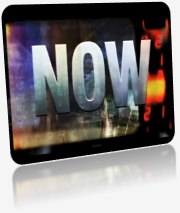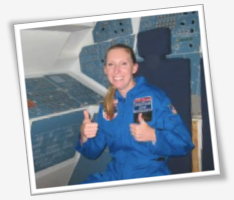 When it comes to taking the next “giant leap” in space exploration, NASA is thinking small — really small – really, really small. In this NASA Now program, Dr. Mike Oye describes how researchers can deliberately order and structure matter at the molecular level to watch amazing new properties emerge.
When it comes to taking the next “giant leap” in space exploration, NASA is thinking small — really small – really, really small. In this NASA Now program, Dr. Mike Oye describes how researchers can deliberately order and structure matter at the molecular level to watch amazing new properties emerge.
Dr. Oye is developing applications for energy-harvesting nanowires. Nanowires could be woven into special clothing for an astronaut. As the astronaut moves around, the tiny nanowires within the clothing collect charges produced by the mechanical vibrations of the astronaut’s movement. The resulting electricity can be used to power equipment aboard a spacecraft.
Link to the NES Virtual Campus home page.
 If you are an NES participant in the 2010-2011 school year, you can now register for the upcoming school year. When logging onto the Virtual Campus, you will receive a prompt to fill out a brief enrollment form where you can make updates to personal, classroom or school information.
If you are an NES participant in the 2010-2011 school year, you can now register for the upcoming school year. When logging onto the Virtual Campus, you will receive a prompt to fill out a brief enrollment form where you can make updates to personal, classroom or school information.
 As students in NASA Explorer Schools educator Kaci Heins’ class worked through the Smart Skies NES module, she thought it would be amazing if she could take a field trip out to her local airport to see air traffic controllers in action. Heins arranged for her students to go up inside the air traffic control tower, talk to the controllers, and see the planes take off and land. The students learned how the controllers keep the passengers and the planes safe. They also visited the airport fire station where the students saw the trucks, tried on the fire gear, and saw the truck spray water across the tarmac. Heins reports, “It was one of the best field trips I have ever done and the students loved every second of it! It is experiences like these that can make the biggest impact on our students. I hope you can try to work something out like this in your area!”
As students in NASA Explorer Schools educator Kaci Heins’ class worked through the Smart Skies NES module, she thought it would be amazing if she could take a field trip out to her local airport to see air traffic controllers in action. Heins arranged for her students to go up inside the air traffic control tower, talk to the controllers, and see the planes take off and land. The students learned how the controllers keep the passengers and the planes safe. They also visited the airport fire station where the students saw the trucks, tried on the fire gear, and saw the truck spray water across the tarmac. Heins reports, “It was one of the best field trips I have ever done and the students loved every second of it! It is experiences like these that can make the biggest impact on our students. I hope you can try to work something out like this in your area!” In this episode of NASA Now, Camille Alleyne, Assistant Program Scientist for the International Space Station discusses the unique research environment onboard the ISS while sharing information about many of the past, present and planned experiments. To date, more than three hundred experiments have been conducted on the ISS. Through this research, we will better understand the effects of microgravity on the human body, further develop technology, and expand our knowledge about our Earth and about the universe.
In this episode of NASA Now, Camille Alleyne, Assistant Program Scientist for the International Space Station discusses the unique research environment onboard the ISS while sharing information about many of the past, present and planned experiments. To date, more than three hundred experiments have been conducted on the ISS. Through this research, we will better understand the effects of microgravity on the human body, further develop technology, and expand our knowledge about our Earth and about the universe. Patricia Smeyers, a teacher from Secaucus Board of Education, has a great idea for a Lunar Rover Project. Students design a new lunar rover for the future. They create their designs using cloud-based 3-D modeling software and present their engineered 3-D model and research.
Patricia Smeyers, a teacher from Secaucus Board of Education, has a great idea for a Lunar Rover Project. Students design a new lunar rover for the future. They create their designs using cloud-based 3-D modeling software and present their engineered 3-D model and research. Liz Warren, NASA Johnson Space Center operations lead for the International Space Station Medical Project, discusses why exercise and nutrition are important to maintaining good health on Earth and even more important to astronauts on the International Space Station. She also discusses how living in space causes changes in the human body such as loss of bone density, decreased cardiovascular fitness, and muscle atrophy. Astronauts participate in experiments to measure changes in their bodies so that we can prevent those types of changes in the future.
Liz Warren, NASA Johnson Space Center operations lead for the International Space Station Medical Project, discusses why exercise and nutrition are important to maintaining good health on Earth and even more important to astronauts on the International Space Station. She also discusses how living in space causes changes in the human body such as loss of bone density, decreased cardiovascular fitness, and muscle atrophy. Astronauts participate in experiments to measure changes in their bodies so that we can prevent those types of changes in the future.
 When it comes to taking the next “giant leap” in space exploration, NASA is thinking small — really small – really, really small. In this NASA Now program, Dr. Mike Oye describes how researchers can deliberately order and structure matter at the molecular level to watch amazing new properties emerge.
When it comes to taking the next “giant leap” in space exploration, NASA is thinking small — really small – really, really small. In this NASA Now program, Dr. Mike Oye describes how researchers can deliberately order and structure matter at the molecular level to watch amazing new properties emerge. This is a cool lesson related to MESSENGER’s mission to Mercury and the Inuit people inhabiting the Arctic region. By studying ancient solutions to the issue of excessive sunlight on human vision, students better understand the process of designing solutions to similar problems for MESSENGER.
This is a cool lesson related to MESSENGER’s mission to Mercury and the Inuit people inhabiting the Arctic region. By studying ancient solutions to the issue of excessive sunlight on human vision, students better understand the process of designing solutions to similar problems for MESSENGER.